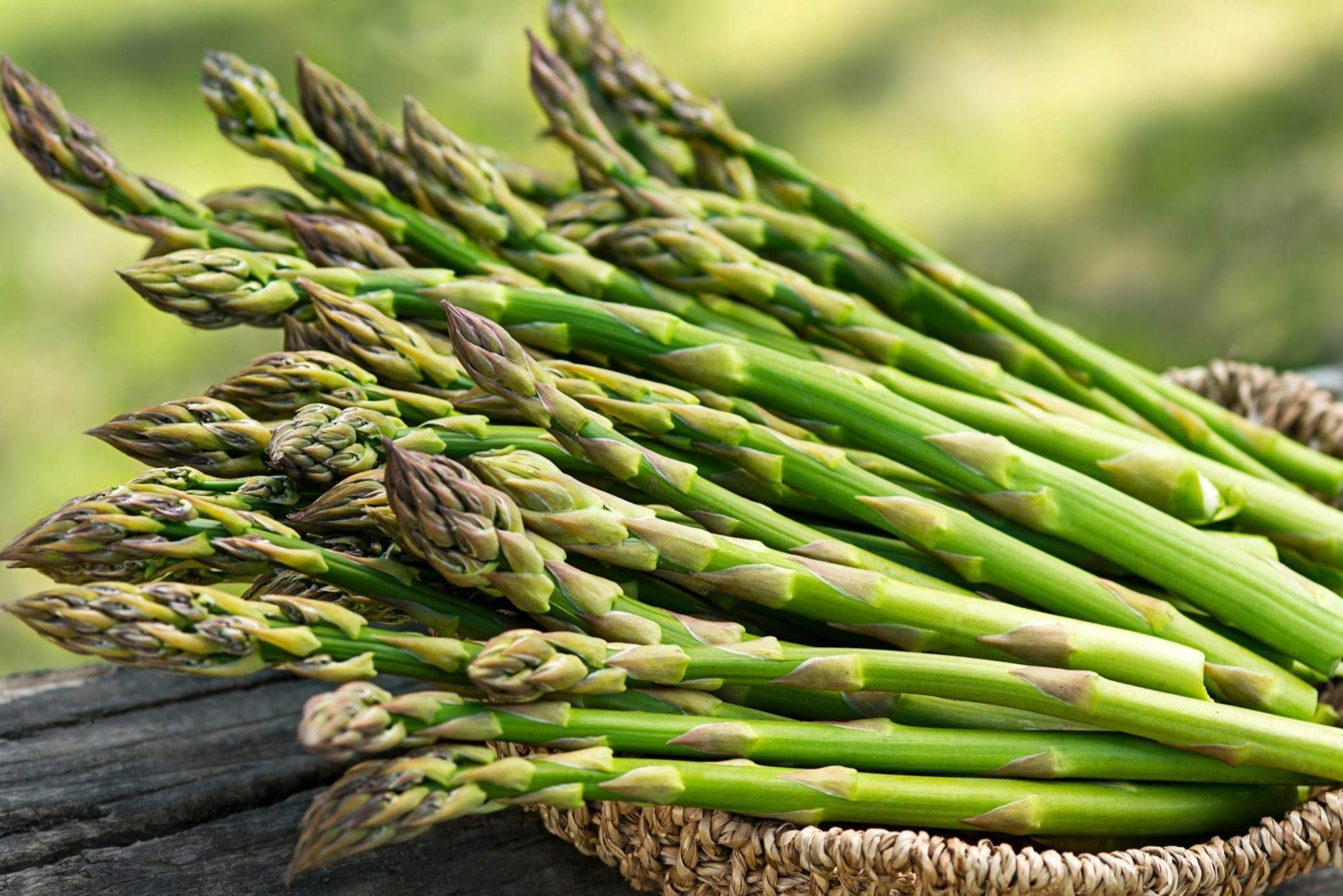Home>Food and Cooking>How To Store Asparagus


Food and Cooking
How To Store Asparagus
Published: February 29, 2024
Learn the best methods for storing asparagus to keep it fresh and flavorful. Get expert tips and tricks for food and cooking.
(Many of the links in this article redirect to a specific reviewed product. Your purchase of these products through affiliate links helps to generate commission for Noodls.com, at no extra cost. Learn more)
Table of Contents
Introduction
Asparagus, with its tender spears and unique flavor, is a versatile and nutritious vegetable that can elevate any dish. Whether you enjoy it steamed, roasted, grilled, or sautéed, the key to savoring its freshness and flavor lies in proper storage. Knowing how to store asparagus correctly can extend its shelf life and preserve its quality, ensuring that you can enjoy this delectable vegetable at its best.
Proper storage not only maintains the crispness and flavor of asparagus but also helps to retain its essential nutrients. Asparagus is a rich source of vitamins A, C, E, and K, as well as folate and fiber. By storing it correctly, you can ensure that these valuable nutrients remain intact, allowing you to reap the full health benefits of this vibrant green vegetable.
In this comprehensive guide, we will explore various methods for storing asparagus, including refrigeration, freezing, and water storage. Additionally, we will delve into tips for keeping asparagus fresh for an extended period, allowing you to minimize waste and maximize enjoyment. Whether you have a bountiful harvest from your garden or have purchased a fresh bunch from the market, understanding the best storage practices for asparagus is essential for maintaining its quality and flavor.
By learning the art of proper asparagus storage, you can elevate your culinary creations and relish the delightful taste and texture of this beloved vegetable. Let's embark on this journey to discover the most effective techniques for storing asparagus, ensuring that it remains a delightful addition to your meals for days to come.
Read more: How To Store Bacon Grease
Choosing the Right Storage Method
When it comes to preserving the freshness and flavor of asparagus, selecting the appropriate storage method is crucial. The chosen method should align with your intended timeline for consuming the asparagus, as well as the available resources at your disposal. Here are the key factors to consider when choosing the right storage method for asparagus:
-
Freshness: If you have just harvested or purchased fresh asparagus, it is essential to prioritize methods that maintain its crispness and vibrant color. Refrigeration and water storage are ideal for preserving the freshness of asparagus in the short term, while freezing can be employed for longer-term storage.
-
Convenience: Consider the level of convenience offered by each storage method. Refrigeration provides a simple and accessible way to keep asparagus fresh, while freezing requires more preparation and space. Water storage, on the other hand, offers a unique method that can maintain asparagus freshness while also showcasing its beauty.
-
Flavor Retention: Retaining the natural flavor of asparagus is a top priority. Refrigeration helps to slow down the degradation of flavor compounds, while freezing can lock in the taste for an extended period. Water storage, although not as common, can also contribute to preserving the flavor by keeping the asparagus hydrated.
-
Nutrient Preservation: Asparagus is packed with essential nutrients, and the chosen storage method should aim to preserve these valuable elements. Refrigeration and freezing are effective in maintaining the nutritional integrity of asparagus, ensuring that you can enjoy its health benefits even after storage.
-
Longevity: If you anticipate a longer duration before consuming the asparagus, freezing becomes a viable option. However, if you plan to use the asparagus within a few days, refrigeration or water storage may be more suitable.
By considering these factors, you can make an informed decision regarding the most suitable storage method for your asparagus. Each method offers distinct advantages, and understanding their respective benefits will enable you to preserve the quality and freshness of asparagus according to your specific needs and preferences.
Storing Asparagus in the Refrigerator
Refrigeration is one of the most popular and effective methods for storing asparagus, especially when you plan to consume it within a few days. Proper refrigeration helps to maintain the crispness and flavor of asparagus, ensuring that it remains fresh and vibrant until you are ready to use it in your culinary creations.
To store asparagus in the refrigerator, start by trimming the woody ends of the spears. This can be done by gently bending each spear near the base until it naturally snaps, indicating the point where the tender portion begins. Alternatively, you can use a knife to trim the ends, cutting about an inch from the base. This step is crucial as it removes the tough, fibrous portion of the asparagus, promoting better storage and enhancing the eating experience.
Once the asparagus spears are trimmed, it's important to keep them hydrated to prevent wilting. To achieve this, place the spears upright in a container or jar filled with about an inch of water. Cover the container loosely with a plastic bag, securing it around the asparagus bunch with a rubber band. This setup creates a humid environment that helps to retain the asparagus's natural moisture, keeping it crisp and fresh.
Alternatively, if you prefer not to use water, you can wrap the trimmed asparagus in a damp paper towel and store it in a perforated plastic bag. The damp paper towel mimics the effect of water storage by providing the necessary moisture to keep the asparagus hydrated.
It's important to place the asparagus in the refrigerator's vegetable crisper drawer, which offers a slightly higher humidity level than the rest of the refrigerator. This specialized compartment helps to preserve the asparagus's texture and flavor more effectively.
When storing asparagus in the refrigerator, it's advisable to use it within 3 to 4 days for the best quality. Asparagus tends to deteriorate over time, and consuming it within this timeframe ensures that you can enjoy it at its peak freshness.
By following these simple yet effective steps for refrigerating asparagus, you can prolong its shelf life and maintain its delightful crunch and flavor. This method allows you to have fresh asparagus readily available for various culinary endeavors, whether it's a refreshing salad, a flavorful stir-fry, or a delightful side dish.
Storing Asparagus in the Freezer
When you have an abundant supply of asparagus or simply want to preserve this delectable vegetable for future use, freezing offers a convenient and effective storage solution. Freezing asparagus allows you to extend its shelf life significantly while retaining much of its flavor and nutritional value. By following the proper steps for freezing asparagus, you can ensure that it remains in optimal condition for use in a variety of dishes, from soups and stews to casseroles and stir-fries.
To begin the freezing process, start by washing the asparagus thoroughly under cold running water to remove any dirt or debris. Once cleaned, carefully trim the woody ends of the spears, similar to the process for refrigeration. The asparagus can then be blanched to preserve its texture, color, and flavor before freezing. Blanching involves briefly immersing the asparagus in boiling water, followed by a quick plunge into ice water to halt the cooking process. This step helps to deactivate enzymes that can cause deterioration, ensuring that the asparagus maintains its quality during freezing.
After blanching, it's important to thoroughly dry the asparagus to remove excess moisture, which can lead to freezer burn. Once dried, the asparagus can be arranged in a single layer on a baking sheet and placed in the freezer for a few hours to individually quick-freeze the spears. This prevents them from sticking together and allows for easy portioning when it's time to use them in recipes.
Once the asparagus spears are individually frozen, transfer them to airtight freezer bags or containers, removing as much air as possible to minimize the risk of freezer burn. Properly sealed packaging helps to maintain the asparagus's freshness and flavor during storage. Be sure to label the bags or containers with the date of freezing to keep track of their freshness.
When it comes to using frozen asparagus, there's no need to thaw it before incorporating it into your dishes. Frozen asparagus can be added directly to soups, stir-fries, or other cooked dishes, allowing for convenient and versatile usage. Whether you're preparing a hearty vegetable soup or a flavorful pasta dish, having frozen asparagus on hand provides a convenient way to enhance your culinary creations with this vibrant and nutritious vegetable.
By following these steps for freezing asparagus, you can extend its availability and enjoy its delightful taste and nutritional benefits throughout the year. Freezing allows you to harness the essence of fresh asparagus, ensuring that it remains a valuable ingredient in your culinary repertoire, regardless of the season.
Storing Asparagus in Water
Storing asparagus in water is a unique and visually appealing method that can effectively preserve its freshness and crispness. This approach not only maintains the vibrant green color of the spears but also keeps them hydrated, ensuring that they remain tender and succulent until you are ready to use them in your culinary endeavors.
To store asparagus in water, begin by trimming the woody ends of the spears, similar to the process for refrigeration and freezing. This step is essential for promoting better storage and enhancing the eating experience. Once the asparagus spears are trimmed, place them upright in a container or jar filled with about an inch of water. The container should be tall enough to support the asparagus spears in an upright position, allowing them to absorb water effectively.
Cover the container loosely with a plastic bag, securing it around the asparagus bunch with a rubber band. This setup creates a humid environment that helps to retain the asparagus's natural moisture, preventing wilting and maintaining its crisp texture. The visual impact of storing asparagus in water is particularly striking, as the vibrant green spears stand upright in the container, adding a touch of elegance to your refrigerator or countertop.
It's important to change the water every two days to ensure that the asparagus remains fresh and hydrated. By refreshing the water regularly, you can prevent the spears from becoming limp and maintain their optimal texture and flavor. This simple maintenance step contributes to the longevity of the stored asparagus, allowing you to enjoy it at its best for an extended period.
Storing asparagus in water offers a delightful visual display while effectively preserving its quality. This method is particularly suitable for showcasing freshly harvested asparagus, as it highlights the natural beauty of the spears. Whether you have a bountiful supply from your garden or a fresh bunch from the market, storing asparagus in water provides a charming and practical way to maintain its freshness and appeal.
By embracing the method of storing asparagus in water, you can elevate the presentation of this beloved vegetable while ensuring that it remains a delightful and flavorful addition to your meals. This unique approach adds a touch of elegance to asparagus storage, allowing you to savor its vibrant green hues and delectable taste with every use.
Read more: How To Store Kale
Storing Asparagus in the Pantry
Storing asparagus in the pantry is a lesser-known but viable method that can be employed when refrigerator space is limited, or when a unique approach to asparagus storage is desired. While the pantry is not typically associated with vegetable storage, asparagus can be successfully stored in this environment under the right conditions. This method is particularly suitable for short-term storage when the intention is to consume the asparagus within a few days.
To store asparagus in the pantry, it's essential to prioritize a cool and dark location that offers consistent temperatures. Excessive exposure to light and warmth can lead to the rapid deterioration of asparagus, causing it to lose its crispness and flavor. Therefore, selecting a suitable spot within the pantry is crucial for maintaining the quality of the stored asparagus.
Start by trimming the woody ends of the asparagus spears, similar to the process for other storage methods. This step is essential for promoting better storage and enhancing the eating experience. Once the spears are trimmed, wrap them in a slightly damp paper towel to maintain their moisture and prevent wilting. The damp paper towel mimics the effect of water storage by providing the necessary hydration to keep the asparagus fresh.
Next, place the wrapped asparagus in a perforated plastic bag to allow for air circulation while preventing excess moisture buildup. The perforations in the bag help to regulate the airflow, ensuring that the asparagus remains in optimal condition during pantry storage.
When storing asparagus in the pantry, it's important to monitor the ambient temperature to prevent fluctuations that can compromise the quality of the vegetable. Ideally, the pantry environment should maintain a cool and consistent temperature, free from exposure to direct sunlight or heat sources.
By employing this method, you can effectively store asparagus in the pantry for a few days, ensuring that it remains fresh and ready for use in your culinary creations. Whether you plan to incorporate it into a savory omelet, a refreshing salad, or a flavorful pasta dish, properly stored asparagus from the pantry can elevate your meals with its vibrant color and delightful flavor.
Storing asparagus in the pantry offers a convenient alternative when refrigerator space is limited, providing a practical solution for short-term storage. By following these simple steps, you can ensure that your pantry-stored asparagus maintains its quality and contributes to a delightful culinary experience.
Tips for Keeping Asparagus Fresh
Ensuring the freshness and quality of asparagus extends beyond the initial storage method. Implementing additional tips and practices can further enhance the longevity and appeal of this vibrant vegetable, allowing you to savor its delightful flavor and texture over an extended period. Here are valuable tips for keeping asparagus fresh:
-
Proper Handling: Handle asparagus with care to prevent bruising or damage to the delicate spears. Avoiding rough handling helps to maintain the integrity of the vegetable, preserving its crispness and visual appeal.
-
Storage Location: Store asparagus away from ethylene-producing fruits such as apples, bananas, and tomatoes. Ethylene gas can accelerate the deterioration of asparagus, leading to a loss of freshness and flavor. Keeping asparagus separate from ethylene-emitting produce helps to prolong its shelf life.
-
Frequent Inspection: Regularly inspect stored asparagus for any signs of wilting or decay. Removing any deteriorating spears promptly can prevent the spread of spoilage and preserve the quality of the remaining asparagus.
-
Trimming Method: When preparing asparagus for storage, consider using a gentle trimming method to avoid unnecessary waste. Instead of cutting the ends, consider using a vegetable peeler to remove the tough outer layer, preserving more of the edible portion and minimizing discard.
-
Optimal Humidity: Maintain the appropriate humidity level when storing asparagus in the refrigerator. The use of a damp paper towel or water storage method helps to keep the spears hydrated, preventing them from drying out and losing their crisp texture.
-
Temperature Control: Ensure that the storage environment, whether in the refrigerator or pantry, maintains a consistent and cool temperature. Fluctuations in temperature can compromise the quality of asparagus, leading to premature deterioration.
-
Minimal Exposure: Limit the exposure of asparagus to light, as prolonged light exposure can cause the vegetable to become woody and lose its vibrant color. Storing asparagus in a dark or opaque container helps to shield it from light, preserving its visual appeal.
-
Regular Rotation: If storing asparagus in the refrigerator, practice regular rotation to use the oldest spears first. This helps to minimize waste and ensures that you enjoy the freshest asparagus in your culinary creations.
By incorporating these tips into your asparagus storage routine, you can optimize the freshness and quality of this beloved vegetable, allowing you to relish its delightful taste and nutritional benefits with every use. Whether you are a culinary enthusiast or simply appreciate the vibrant flavors of fresh produce, these tips serve as valuable guidelines for maximizing the enjoyment of asparagus in your meals.
Conclusion
In conclusion, mastering the art of asparagus storage is essential for preserving its freshness, flavor, and nutritional value. Whether you opt for refrigeration, freezing, water storage, or pantry storage, each method offers unique benefits that cater to different storage durations and preferences. By understanding the nuances of each approach, you can ensure that your asparagus remains a vibrant and delightful addition to your culinary repertoire.
Refrigeration stands out as a convenient and effective method for short-term storage, maintaining the crispness and flavor of asparagus for several days. The use of water or damp paper towels helps to keep the spears hydrated, ensuring that they remain tender and succulent until you are ready to use them. This method is ideal for those who plan to incorporate asparagus into their meals within a few days, allowing for easy access to this versatile vegetable.
On the other hand, freezing offers a practical solution for extending the availability of asparagus, allowing you to enjoy its delightful taste and nutritional benefits throughout the year. Proper blanching and individual freezing ensure that the asparagus retains its texture and flavor, providing a convenient option for long-term storage. With frozen asparagus readily available, you can effortlessly enhance a wide range of dishes with this vibrant and nutritious vegetable.
The unique approach of storing asparagus in water not only preserves its freshness but also showcases its natural beauty. This visually appealing method adds a touch of elegance to asparagus storage, making it a charming addition to your refrigerator or countertop. By changing the water regularly, you can maintain the asparagus's optimal texture and flavor, ensuring that it remains a delightful ingredient in your culinary creations.
For those seeking an alternative to traditional storage methods, pantry storage offers a viable solution for short-term asparagus storage. By maintaining a cool and consistent temperature, asparagus can be stored in the pantry with the help of a damp paper towel and a perforated plastic bag. This method provides a practical option when refrigerator space is limited, allowing you to enjoy the vibrant color and delightful flavor of asparagus within a few days.
Incorporating the recommended tips for keeping asparagus fresh further enhances the effectiveness of each storage method, allowing you to maximize the longevity and appeal of this beloved vegetable. By handling asparagus with care, monitoring the storage environment, and implementing optimal humidity and temperature control, you can ensure that your asparagus remains fresh and flavorful for an extended period.
In essence, understanding the diverse methods and tips for storing asparagus empowers you to make informed decisions based on your specific needs and preferences. Whether you are a culinary enthusiast, a health-conscious individual, or simply someone who appreciates the vibrant flavors of fresh produce, mastering the art of asparagus storage allows you to savor its delightful taste and nutritional benefits with every use.














